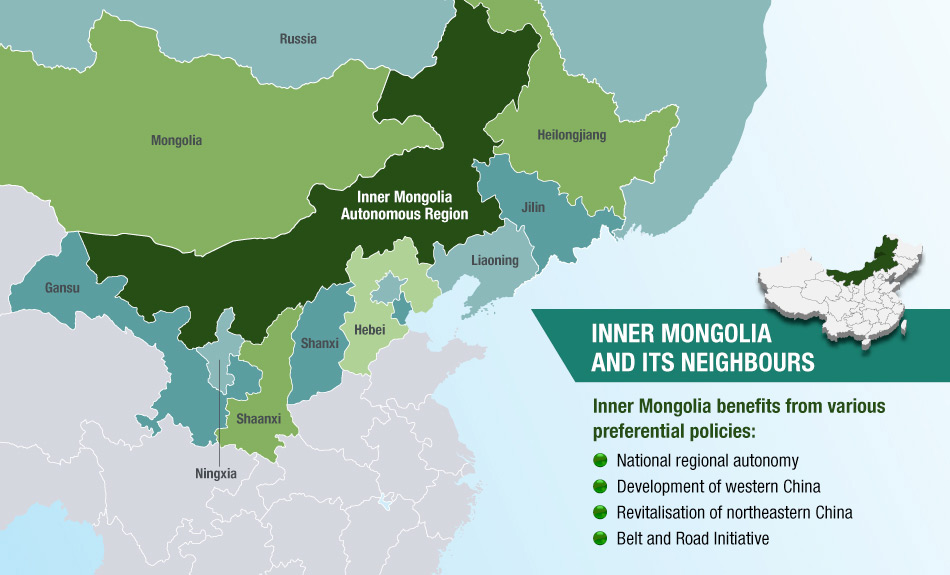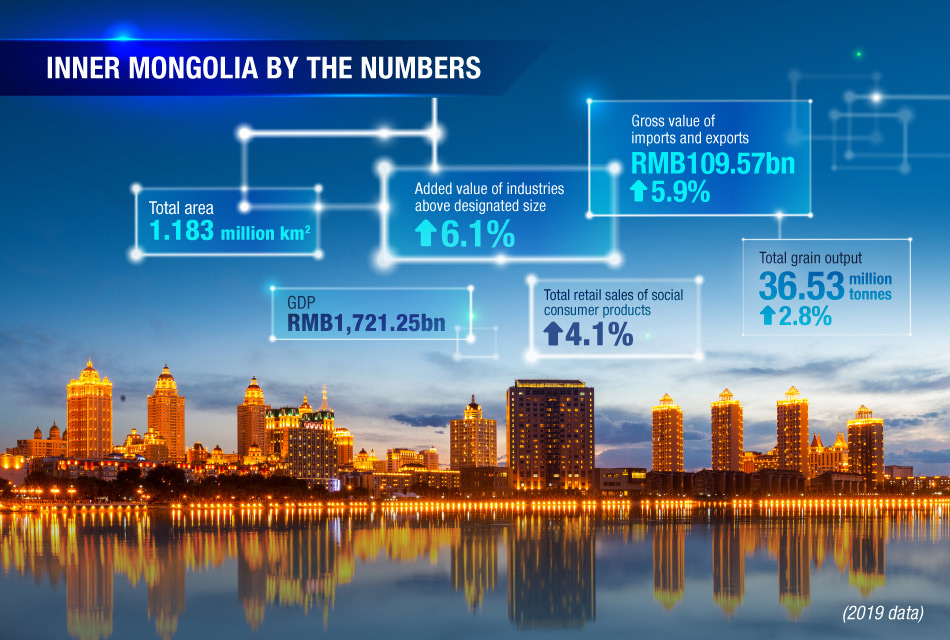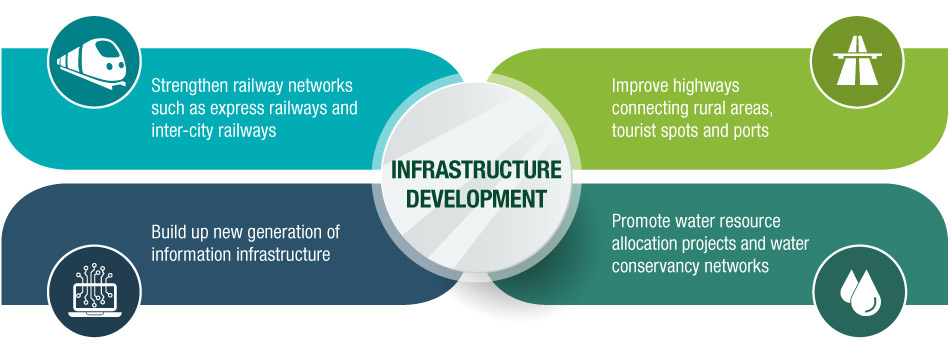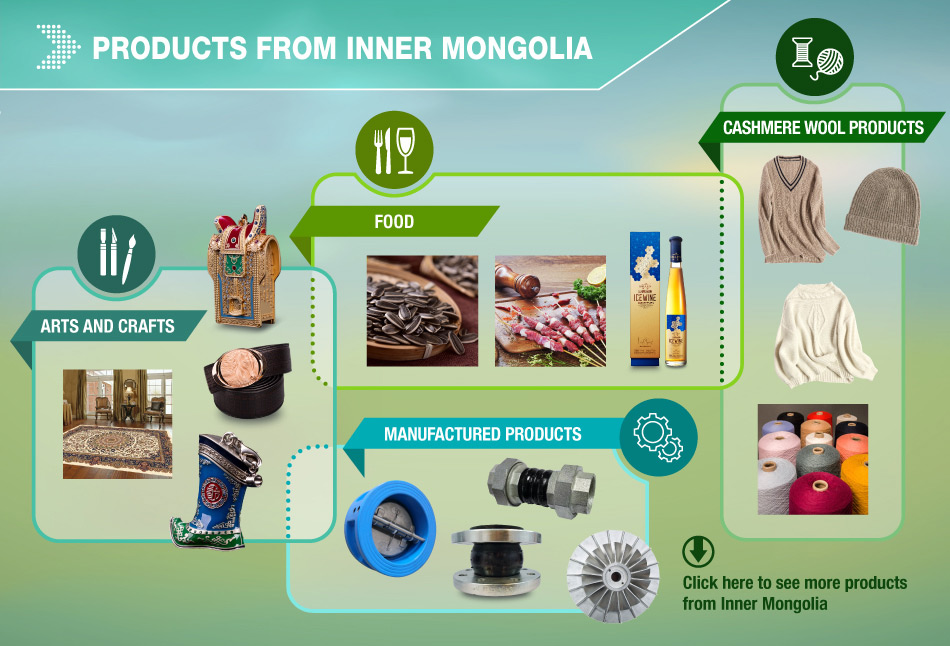Inner Mongolia, an important base for energy production and agricultural and animal products manufacturing in Mainland China, is applying strong efforts to develop emerging industries such as modern manufacturing, new materials, biomedical, electronic information and environmental.
The Inner Mongolia Autonomous Region is located in the northern frontier of Mainland China. It covers 1.183 million km2 or 12.3 per cent of the entire country. The region borders the provinces of Heilongjiang, Jilin and Liaoning to the east, Gansu and Ningxia to the west and Hebei, Shanxi and Shaanxi to the south, with Mongolia and Russia to the north.
With its thick forests, beautiful grasslands, fertile farmlands, broad lakes, wild fauna and flora, as well as numerous subsurface riches, Inner Mongolia is honoured with the reputation of “a land of treasure with forests in the east, iron in the west, crops in the south and nomads in the north”.
Inner Mongolia is the only region in Mainland China that enjoys two preferential policies on national regional autonomy and on the large-scale development of western China and the revitalisation of the northeastern China.
The region is implementing the “Belt and Road Initiative” and supporting a series of policy measures to develop and open up along the border areas, conferring to Inner Mongolia the development orientation of “giving full play to the geographical advantages of connecting Russia and Mongolia and building an important window of Mainland China’s opening to the north”.

Economic figures
According to preliminary calculations, the GDP of Inner Mongolia reached RMB1,721.25bn in 2019. The total grain output of the whole province increased 2.8 per cent and reached 36.53 million tonnes. In addition, beef output increased 3.8 per cent to 638,000 tonnes, mutton output increased 3.2 per cent to 1.098 million tonnes and diary output increased 2.1 per cent reaching 5.772 million tonnes. The added value of industries above designated size increased by 6.1 per cent compared to the previous year, while the gross value of imports and exports increased 5.9 per cent, reaching RMB109.57bn. The gross value of imports and exports with countries along the Belt and Road Initiative stands at RMB71.3bn. The added value of the tertiary industry in Inner Mongolia has increased by 5.4 per cent. The total retail sales of social consumer products in Inner Mongolia increased by 4.1 per cent compared with the previous year.
Development plans
Infrastructure constructionCurrently under way is the accelerated improvement of express railways and inter-city railways, highways, regional and general airports and urban underground pipeline networks including gas and heating. In addition, water resource allocation projects such as the diversion of Chuo’er River to benefit West Liaohe River and the expansion of water conservancy networks such as matching renovation projects in large and medium-sized irrigation areas in Hetao Plain are in progress. Other projects include strengthening energy networks with UHV outward transmission channels, upgrading and transforming regional backbone power grids, improving north-south coal transportation channels, and building up information communication networks with the new generation of information infrastructure.

Development of strategic emerging industries
Several areas of development are new energy industries such as wind-powered heating, distributed photovoltaic power plants, bioenergy and nuclear fuel. The region is seeing the expansion and strengthening of new material industries such as rare earth, graphite (alkene), high-quality alloy and advanced composite materials. In addition, advanced manufacturing industries are being introduced and developed, such as new energy automobiles, industrial robots, high-performance medical machinery. The region is strongly promoting the development of environmental industries such as coal, carbon and clean electricity production, comprehensive utilisation of resources, advanced environmental technology and equipment, highly efficient water-saving agriculture and environmental management. Finally, there has been vigorous development in areas such as modern breeding and agriculture, animal husbandry product innovation platforms, as well as biomedical industries such as modern Mongolian traditional Chinese medicine, genetically engineered drugs and new chemical drugs.

Superior conditions for the development of the big data industry
The construction of a comprehensive big data experimental zone in Inner Mongolia has been approved and cloud computing data centres have already been built in Hohhot, Baotou, Ulanqab and Ordos. Beginning with the implementation of big data in government affairs, infrastructure planning, social governance, public services, agriculture and animal husbandry, poverty alleviation, finance and personnel training, Inner Mongolia is poised to promote deeper regional integration of the Internet, big data, artificial intelligence with the real economy.
Transformation and upgrade of traditional industries
The region is focused on introducing advanced technology and equipment, speeding up the application of advanced coal-fired power plants and the modern coal chemical industry, extending the industrial chain of iron and steel and non-ferrous metals, speeding up the industrialisation development of extracting alumina from high alumina fly ash and promoting the upgrade and replacement of polyvinyl chloride, coking, calcium carbide and cement, building materials and glass industries. Furthermore, the region is strongly promoting the intensive processing of dairy, meat, wool, grain and oil and the development of modern agriculture and animal husbandry to create a distinctive green grassland brand.
The development of a modern service industry
The integration of grassland culture and tourism industry in Inner Mongolia is being accelerated with a focus on attracting international tourism based around the four seasons. The region is also speeding up the development of its financial industry by attracting large financial institutions to set up various licensed branches and subsidiaries in order to build a varied, multi-level modern financial system. Also under way are the development of productive and active services, the construction of a number of large-scale logistics parks, logistics distribution centres and e-commerce demonstration cities and the cultivation of new service industries such as cultural creativity, fitness and leisure, elderly care, medical rehabilitation and education and training.
Opening up and development
Regional and international links will be strengthened by optimising the service of China-Europe trains from Guangzhou, Suzhou, Qingdao, Changchun, Zhengzhou and Yiwu through Inner Mongolia to Europe, as well as by promoting the construction of China-Europe train hubs such as the Logistics Transfer Center and Airport Logistics Park. An export-oriented economy and pan-port economy will be developed through various ports, comprehensive bonded zones and cross-border cooperation zones.
Industry advantages
After many years of effort, Inner Mongolia has upgraded several of its miscellaneous products to large-scale industries by virtue of its location, market and industry advantages along with its vast resources. As a result, eleven state-level bases have been created for the transformation and upgrade of foreign trades, which generate products such as cashmere, ferrous materials, rare earth elements, equipment construction, beef products, tomato products, seeds, green and red bell peppers, cereals and beans. Currently, seeds produced in Inner Mongolia account for over 70 per cent of the national market of exports, making the region an important production and distribution centre of the export of seed products in Mainland China.Regionally produced cashmere products, especially cashmere scarves, constitute up to 50 per cent of the global market. In addition, Inner Mongolia is the second biggest base for the production and processing of tomato materials and the biggest producer of green and red bell peppers in Mainland China. The biggest comprehensive research institute for rare earth elements is located in Baotou and employs nearly 2,000 professionals.
Bases for the transformation and upgrade of foreign trade in the region have so far witnessed 5,926 patent authorisations, 441 specialties with independent brands, 15 of Mainland China’s well-known brands, 35 international independent marketing networks and 30 platforms for public service, all of which have laid a solid foundation for the intensive development of high-end brands of exports.
The Inner Mongolia Autonomous Region Department of Commerce
- The Inner Mongolia Autonomous Region Department of Commerce is responsible for the commercial duties, national and international trade, international economic co-operation and foreign investment and port management in Inner Mongolia.
- Address: Building 5, No. 63 Xinhua Street, Xin Cheng District, Hohhot City 010050, Inner Mongolia Autonomous Region, China
- Tel: 86-471-6946-796 / 86-471-6945-904
- Fax: 86-471-6946-796
- Email: nmgswtxh@163.com


